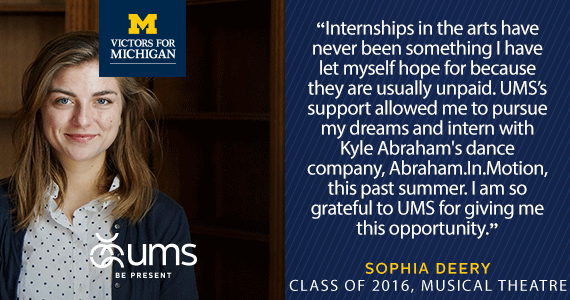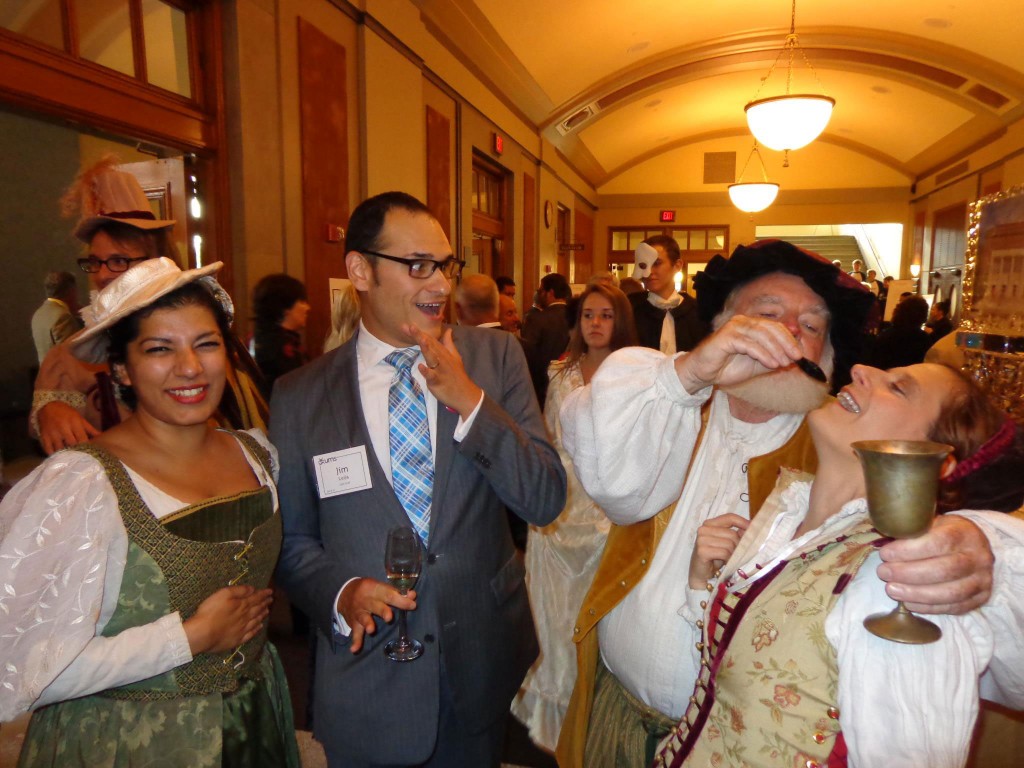Welcome, Omar Offendum
For the upcoming season, UMS is excited to welcome Omar Offendum, a Syrian American rapper, poet, hip hop artist and activist, as the 2018-2019 Education and Community Engagement Research Residency Artist.
Interview by Allie Taylor

Offendum, who is also a Kennedy Center Citizen Artist Fellow — one of just five nominated throughout the country — plans to use his time with UMS to develop a project that aims to help Arab Americans better understand their identity in the U.S., and inform people about the refugee crisis, immigration, and what it means to be Arab American. He plans to present the project he will be working on during his residency at the Kennedy Center next year.
Offendum, who was born in Saudi Arabia, grew up in Washington, D.C. He attended an Arab school which combined curricula from the Middle East for Arab and Islamic studies with the local U.S. curriculum for other subjects. His studies included Arabic poetry, which served as a preliminary inspiration for his own work.
“(Arabic poetry) is what many people describe to be the backbone of the Arabic language,” Offendum said. “Poetry is a very integral part of our culture. As is music.”
Offendum studied architecture at the University of Virginia. During his time there, he began to experiment with making beats and songwriting, and found his true passion in artistic expression through music. As a Syrian-American, Offendum has much to say regarding his experience in America with a hybridized identity, and aims to explain exactly who he is and why he’s proud of the cherished culture he comes from.
A year and a half after graduating from college, Offendum moved to Los Angeles to work for an architecture firm for 10 years. While working as an architect, he was also working as a musician, building his platform and social media following and moonlighting as a performer/rapper. “I love architecture and always will, but I moved toward the aspect of artistic expression that I was most drawn to at the time: music, rapping, and performing. I get a great sense of gratification from performing that has driven my career.” Offendum, who describes hip-hop as being the “sonic upbringing of his youth”, hopes to build bridges culturally, lyrically, and musically with his work.
What do you hope to achieve during your time at UMS as this season’s Research Residency Artist?
“I’m really excited about my time at UMS. I’ve got a couple projects that I’d like to work on, but one in particular is kind of like the next phase of my performance. I’ve been moving further into the direction of theatrical, live music performances. When I started out initially I was rapping with a DJ, which is awesome and I’ll continue to do that, but I’ve been incorporating a lot more live music into my performances these days, namely Arabic instrumentation, blending and fusing it with Western music and instrumentation.”
Offendum is pulling from a number of well known Arabic stories and aspects of culture to use as a lens through which he can examine his ideas.
“In my music and in my performances, I have been working to help Arab Americans better understand their story, to help immigrants understand immigration here in the U.S., to help Americans better understand America in more cohesive way, and to help inform a lot of what is happening today in terms of the refugee crisis and immigration in America. Hopefully by the end of my time, I’ll have some semblance of a foundation to be able to perform it for people. Being in Michigan is really great because first, it’s Michigan, but also, the proximity to Dearborn and being able to work with all the incredible Arab musicians who live in Dearborn will be a great asset. Also, all the resources at the University that are at my disposal will definitely be very helpful, from Arabic professors, to people working in the realm of hip hop, and Arab American studies. And then there’s Detroit, where there’s this incredibly rich heritage — from Motown to J. Dilla. So, I look forward to being able to tap into all of those things, and being inspired to get this project going. I already know it’s a labor of love, so what folks see and hear in March might not resemble at all what the final manifestation might be, but I’m excited for this to be the first step and stab at that.
I’m really grateful that I have this opportunity with UMS to be able to flesh it out and work on it, so that when I present it in Washington D.C. the following month, it can just be that much more awesome.”
Do you consider your art to have political motivation? How would you say your art has changed in the past 5 years? In the current political climate?
“I hate to be described as a “political rapper”. That’s not how I approach my work. I try to write and speak to my experience as thoughtfully, honestly and articulately as I can. It just so happens that I am from Syria, and I am living in the U.S. in 2018 with a Muslim background and an immigrant story, so that by nature becomes a political act every time I get on stage. It’s something that I’ve maintained for well over a decade. Halfway through my college career 9/11 happened, and I quickly saw I could use this art and music and poetry as a way to bridge these seemingly opposed sides of my identity together in a way that was meaningful to me, and to people who were having a difficult time understanding what was going on with the U.S./Middle East politics and relations.
At the end of the day, it’s not about telling people what I’m not. It’s about bridge building. It’s meeting people where they’re at. I’m not afraid to reach out and introduce people to my culture in a way that is digestible and relatable. But also in that, to not dumb it down in any way, because I think it can easily happen. I don’t want to fetishize and romanticize and give people some sort of exotic experience. I just want to tell people exactly what it is what I do, and where I’m from, and why I love it. And in that, there’s also the ability to speak to this “new” experience of being an Arab American. It’s really not that new, it’s been around for over a hundred years, so it’s important for people to understand that even what they might think of as “American” is a lot more diverse and has always been. That, in fact, is what America is. America has always been much bigger of an idea and of a place and of something to strive for, and i just try to remind people of that.”
You’re going to be doing a talk on Thursday October 18, called “Syrianamerican: A Nation State of Mind”. What can people expect from the event?
“SyrianAmericana is the name of my first solo album. It very much who I am and what my work embodies: building bridges with these two/multiple communities I am a part of and have the honor of representing around the world. It is an experience that seeks to connect a lot of things that, sadly, because of the state of affairs between the U.S. and the Middle East these days, have been disconnected by the media for various reasons — to justify wars, or immigration policies — but my work tries to push back on that.
What I will be talking about in the class is giving people a backstory on me and the work that I do and why I do what I do (using examples from artists who’ve inspired me over the years). I’ll also be reciting verses that I’ve written along the way that speak to different points in my career, and performing songs. It’ll be equal parts presentation and conversation. I look forward to having folks engage, ask questions, and tell me what they think. I know that I have a particular perspective(s) on what it means to be Arab American, but I also know that for folks in Dearborn and Detroit, and that’s also something that is unique in itself too, so I look forward to hearing from the students and teachers about that as well.”
What is your ultimate goal with your art? What is the ultimate message you are trying to send?
“My goals are embedded in the themes and ideas of my work and how I approach my work. At the end of the day, if I’m able to just make people happy, comfortable, and more at ease, then I’ve done my job. And certainly within that there’s this desire to “break down misconceptions” about Arabs and Muslims and Syrians, but it’s not on the nose like that. It’s much more the fact that the medium is the message, that people see me as this confident, immigrant Muslim male, who can rap and who can pull from Arab poetry and do all this stuff. In that there is a message that obviously counters what they’re used to hearing about people who might have this background, and I think that’s important.
But also, most importantly, I’m indebted to hip hop culture, and with that, clearly, African American culture. There’s no separating one from the other, so I very much want to make sure that people from those communities appreciate my voice and my perspective, and know that I’m not doing it in a way that is parasitic or disingenuous. I recognize always that this is an African American artform that I am drawing inspiration from and that I’m speaking my experience through, so that’s also very important to me for people to recognize. And at the same time, you have to understand that it’s bigger than hip hop. Hip hop is the manifestation of something that has been happening for a very long time. Trying to build those bridges across time, and across communities is very important to me, and I think it’s becoming more and more apparent in my work, in the projects I embark upon, and in the spaces I perform in.”
What would you say is your greatest strength as an artist?
“Performing and connecting with audiences in a deep way while I’m on stage is really important to me, but also is the reason why I don’t necessarily love performing for gigantic audiences. I don’t really have those meaningful connections that I get to have when it’s several hundred people in an auditorium, a classroom, a coffee shop, etc. And that has a lot to do with the nature of what I do, which is engaging people in this way, with storytelling. It’s a lot more intimate than what most big festival shows maybe can be, and I enjoy that. I enjoy being able to look into people’s eyes. I like being in settings where I’m able to go back and forth with people, and be asked questions, and speak to a lot of these things that I talk about in my music but in a deeper way.
I code and bury a lot of ideas and symbols and imagery and iconography and messages in my lyrics, that could easily go over people’s heads if they don’t get a chance to really dig deeper into them. That’s why I enjoy doing things in classrooms, where we get to talk about them, and talk about the bigger inspirations and ideas behind them. You find comfort in your own voice and your own strengths and that’s really what I’ve been leaning on for quite some time now. It’s important for the next generation of Arab, Syrian and Muslim kids here to have that example. As I mature as an artist, I try to still approach my work with a sense of humility and remind people that there is still a lot to learn and there is always room for growth.”
—
The UMS ECE Research Residency is a competitive program that provides time and resources for an early career artist to spend an extended period of time in Ann Arbor developing a new work while sharing their practice with the U-M and southeastern Michigan communities.
Interview: Jillian Walker, UMS Research Residency Artist
For the 2017-18 season, we are excited to welcome Jillian Walker as our Education and Community Engagement Research Residency Artist. The UMS ECE Research Residency provides time and resources for an artist to spend an extended period of time in Ann Arbor developing a new performance work. A graduate of University of Michigan (B.A.) and Columbia University (MFA), Jillian is an established and accomplished artist, dramaturg, playwright, writer, and activist.
During her time with UMS, Jillian will be developing her latest project, a play called Tignon, inspired by a late 18th century law in New Orleans that required women of color to wear a covering—called a tignon—on their heads to hide their hair. Through this project, Jillian hopes to use “this fascinating slice of legal truth as an intersectional site to explore sex, power, policy, religious practice, gender roles, race, and economy in one of the most interesting and still misunderstood American cities our complicated country has to offer.”
We chatted with Jillian about her writing process, decolonizing history, and returning to Ann Arbor.

Jillian Walker. Photo courtesy of the artist.
AT: How did you first come to hear about El Bando du Bierno, the law that required women to wear a Tignon?
JW: It was actually on a blog. I think it was Black Girl with Long Hair, which is a really popular blog. I got an article in my inbox about the law, and I was like: “This can’t be real.” So, I clicked on it and kept reading. I was so fascinated by the fact that this was actually a mandated law. So, I filed it away in my mind and didn’t do anything with it at first. But I held onto it and knew that I would return to it at some point.
AT: Do you feel that the act of coercing non-white women into covering their in 1786 hair instilled a sense of humiliation that women of color still feel today about their hair and overall appearance?
JT: I think that it definitely proves the point that hair has always been political for black women. If we can go all the way back to 1786 for evidence of that, I think that speaks very loudly to relevant cases today. But what I’m finding in my research and what I’m excited to investigate more with UMS, is that black women made the most of that law at the time. They made their wraps really elaborate and they said, “Okay, fine. If we have to cover our hair then it’s going to be in a fabulous way.” But I do think that even with that, it’s sort of impossible to not feel “less than,” and to not internalize the negative side of what happens when we mandate people’s bodies.
AT: You are already quite an accomplished artist and playwright! How do you think this work compares to your other works in terms of your writing process, inspiration, and goals?
JW: I think the main question that I ask in pretty much everything I make is, “How do we heal?” But, I think it will manifest very differently in Tignon. I’m basically constructing a language. I’m trying to see what women in the 1700’s sounded like. They’re living under Spanish rule at this time, so there is Spanish woven into a broken sort of English that is also very directly related to West Africa, because we’re talking about women who have just come from Africa 20 or 30 years before this. I’ve never tried to make a language before. But the thing that’s going to be the same is the deep investigation of whatever world I’m creating, and it usually happens through and in tandem with my own life.
AT: Can you tell me a little bit about the “Speculative Histories” workshop you’re offering in Ann Arbor on MLK day?
JW: The idea for the workshop really came out of this sense that as I was doing research about the edict of the government, and trying to learn more about New Orleans from the perspective of women of color. I had a lot of trouble, and one of the big reasons is that many of these women were illiterate and weren’t writing their stories down. So far, everything I’ve found is written by colonialists–white men at the time who were surveying New Orleans basically to see how viable it was to make money. Every once in a while they mention a black person, and that’s sort of how I’ve been finding information.
So, Speculative Histories is really about the importance of filling in the holes that are left in the narratives not constructed by people of color. This is a revolutionary act that we can all participate in, to imagine those histories, and bring those histories forward, and not just stop at, “Oh, well we don’t know. There’s nothing we can do.” I think this idea that you only get to tell the truth when you win (and in this case winning means access to language and the ability to tell your story in print) is a racist idea or at least a colonialist one. So how do we decolonize this idea of history? I think we do this by valuing imagination as much as we value fact, and by valuing art making and creation as much as we value the census, or whatever. I feel it’s always a really healing thing to go into an imagined space where I can just place myself into those circumstances and construct the truth out of it. So the workshop will be about that.
AT: What does it mean to you to be developing this piece with UMS and at your Alma Mater?
JW: *Does a happy dance* Woo! It means a lot! It feels full circle. The University of Michigan has one of the best libraries in the world that I didn’t take advantage of as an undergrad. Since leaving U-M, I’ve really fallen in love with research. The irony is not lost on me, that I ended up at Michigan, one of the best research institutions in the world, and then came to New York and went to Columbia, which is also a really incredible research institution. So I’m really excited about being back in Ann Arbor. I’m a proud Wolverine, always have been!
AT: What are you looking forward to most about the residency?
JW: I’m looking forward to what will be uncovered; what voices will be speaking. I think part of how I write is by listening, so I’m excited to have my ears open and all of my pores open and hear whatever strikes me.
Jillian Walker is the 2017-18 Education and Community Engagement Research Residency Artist. Her workshop Speculative Histories takes place on Monday, January 15 at 7 pm and is free and open to the public.
UMS Night School: Acting and Dancing Identity – Session 2 Recap
Please note: This post is a part of series about the free and open to the public UMS Night School. UMS Night School: Constructing Identity runs January 18-February 15, 2016.

Photo: Tanya Tagaq, who will be interviewed along with Taylor Mac at the next session of Night School on January 25. Photo courtesy of the artist.
This past Monday, I attended my first UMS Night School session. This was the second session in this year’s series, which focuses on identity and performance.
The session was about acting and dancing identity, with a focus on Young Jean Lee’s Untitled Feminist Show and Straight White Men, both of which were presented by UMS January 21-23, 2016. A discussion also prepared us for next week’s UMS Night School session with special guest artists Tanya Tagaq and Taylor Mac.
Jim Leija (UMS Director of Education and Community Engagement) and Clare Croft (U-M Assistant Professor of Dance) opened the session with an interactive movement activity. We participants picked a gesture that resonated with us from one of the shows we had seen over the weekend (if we had attended one). We were to perform the gestures without speaking, to emphasize the power of the motion we chose. We then got a chance to explain our gestures to each other.
What surprised you?
We discussed identity through acting and dancing, our expectations of the shows, and the role of society in influencing the creation and content of the shows. One of the main questions that was put on the table was: “What surprised you at the shows?” This question propelled a fantastic, insightful discussion about identity and cultural influence on identity.
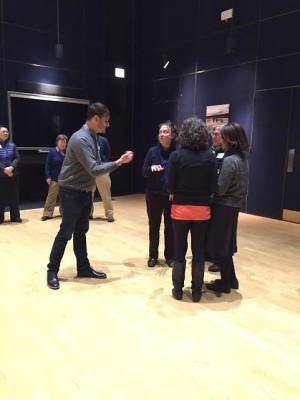 Photo: UMS Night School attendees perform their sound and motion as maestro Jim conducts them.
Photo: UMS Night School attendees perform their sound and motion as maestro Jim conducts them.
Jim and Clare closed the session with another interactive activity in which we created a “soundscape” for a picture that was projected onto a screen. The picture was of dogs pulling a sled through an arctic setting. Our class formed groups of four, and each group came up with a sound and action that we thought described some aspect of the picture. Maestro Jim then conducted the class in performing our sounds together. The result? Super awesome! It was nice to feel a sense of community with people I had never met before.
Having no preconceived expectation of the UMS Night School series, I found the class extremely engaging and by the end, I was so positively overwhelmed with so many new and exciting perspectives that I would’ve otherwise never been introduced to.
If you haven’t yet attended one of these classes, don’t wait any longer! Join us next week for a super exciting session to learn about constructing identity onstage with special guest artists Tanya Tagaq and Taylor Mac!
Student Spotlight: Artist Internships for the 21st Century
The fast changing environment of the 21st century poses new demands on artists. They must reach potential audiences in innovative and unexpected ways. To address these needs, the U-M School of Music, Theatre & Dance and University Musical Society (SMTD and UMS) launched a new student arts internship program for four SMTD undergraduate students in the summer of 2014. Chosen through a competitive application process, each student fellow interned for a minimum of five weeks between May and August 2014 with a professional dance, theater, or music ensemble that UMS planned presented during the 14-15 season. The program will continue and we’re currently selecting fellows for next season.
Explore the journeys of our 14-15 student fellows!
Héctor Flores Komatsu
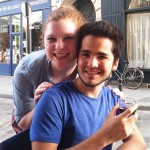 Héctor Flores Komatsu spent five weeks with Théâtre de la Ville in Paris, France. Read his travel stories while embedded with the company and his interview with company members.
Héctor Flores Komatsu spent five weeks with Théâtre de la Ville in Paris, France. Read his travel stories while embedded with the company and his interview with company members.
Libby Seidner
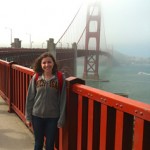 Libby Seidner was embedded with the San Francisco Symphony. Read her travel blog. Libby conducted video interviews with the orchestra, too:
Libby Seidner was embedded with the San Francisco Symphony. Read her travel blog. Libby conducted video interviews with the orchestra, too:
Sophia Deery
Sophia Deery was with Kyle Abraham’s Abraham.In.Motion company. Explore behind the scenes moments from the summer with the company, or photos from company’s residency in Ann Arbor. What she loves about the company’s work:
Hillary Kooistra
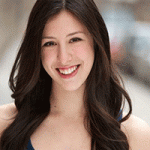 Hillary worked with the Trisha Brown Dance Company. Read her interviews with company members. We also worked with Hillary to create in-depth coverage of our free UMS Night School evening “course” focusing on dance.
Hillary worked with the Trisha Brown Dance Company. Read her interviews with company members. We also worked with Hillary to create in-depth coverage of our free UMS Night School evening “course” focusing on dance.
Interested in more? We can’t wait to introduce our next round of student fellows to you! Keep up with the program here on our blog.
Got questions or suggestions? Share them in the comments below.
At On the Road with UMS
Photo by Bill Shell.
Jim Leija, UMS Director of Education & Community Engagement, with members of the cast of “Shakespeare in the Arb,” Maria Thomas, Martin Walsh, and Jean Leverich at On the Road, our annual fundraiser for UMS Education & Community Engagement programs.


